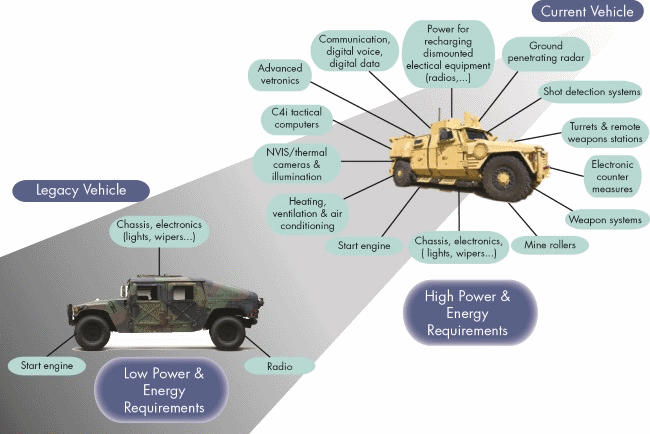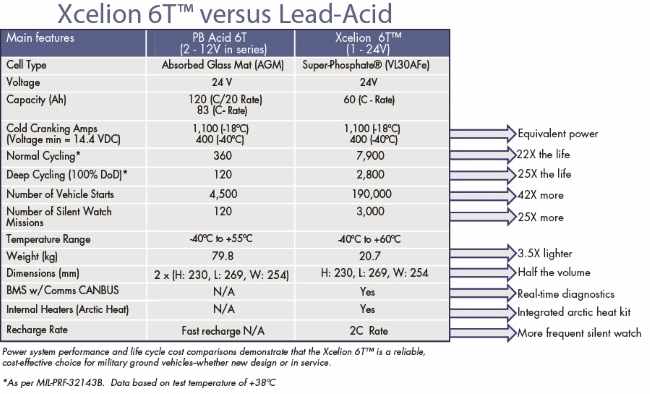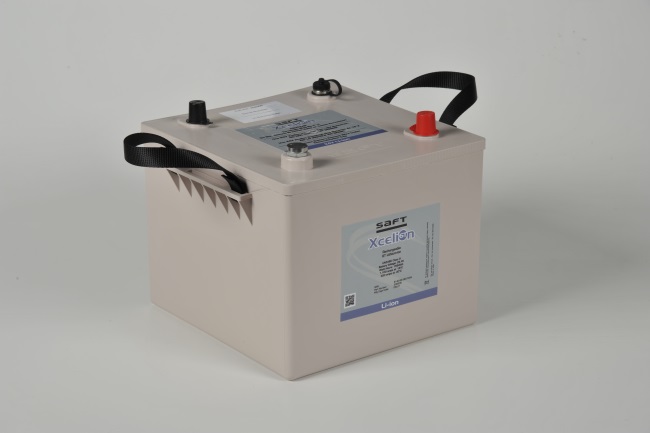ALEX BYNUM, Director of Space & Defense Sales,
Saft,
www.saftbatteries.com
Modern military vehicles, designed for a new generation of warfare, carry more electronics and power-driven components than ever before. Previously, combat and support vehicles only required enough power for radios and electronic systems that could be operated for short time periods without starting the engine. Today’s more complex vehicles (see Fig. 1 ) feature sensors, jammers, communications, controls, drives, optics and powered weapons systems, requiring more energy than traditional Pb-acid chemistry can provide.

Fig. 1: Requirements for military vehicles have changed dramatically from decades ago to today’s vehicles that carry far more electronics and power-driven components than before.
In effect, new and next-generation military motorized assets must function as mobile power plants. The ability to generate significant amounts of electrical power is critical for the full technology spectrum of modern tactical, combat, industrial and hybrid vehicles. The needs of the modern battlefield are forcing electronics designers to reevaluate on-board energy architecture, and how each vehicle’s ever-growing array of sensors, controls and communication systems are powered. Specifically, they’re evaluating the effectiveness of legacy lead-acid 6T (Pb-acid) batteries.
The NATO 6T battery format, the most common battery used in military vehicles around the world, is often comprised of 28-Vdc batteries with two 12-Vdc lead-acid batteries strung in series for ground vehicles. The batteries were originally used only for starting, lighting and ignition (SLI) loads, but as the complexity of integrated vehicle systems increased, the vehicle batteries were also used to provide higher power loads and cycled at up to 80 percent depth of discharge.
The increased strain on lead-acid 6T batteries can cause premature failure by excessive discharge, improper charging, and extreme internal temperatures. In turn, military operators must frequently stock and replace the batteries, resulting in diminished reliability and declining trust by troops during deep-cycle applications. Another shortfall is that State of Charge (SOC)/State of Health (SOH) is difficult to detect, which could cause unexpected power loss, leading to engine start failures, inability to complete missions, and increased danger for soldiers.
The good news is that advances in lithium-ion battery technology (see Fig. 2 ) have created new opportunities for the development of innovative power solutions capable of pushing outdated legacy technology and chemistry aside, allowing engineers to explore new possibilities with their on-board designs.

Fig. 2: Comparison of 6T-format lead-acid vs advanced Li-ion-based battery technologies like the Saft Xcelion.
Advanced Li-ion technology offers many benefits over lead-acid, such as longer life, lighter weight, higher energy density, and lower total cost of ownership. Substantially longer battery life significantly enhances the capabilities of today’s military vehicles, supporting extended silent watch operations (engine-off mode), and a multitude of technologies on the vehicle that run on battery power.
What may be most encouraging related to adapting existing vehicles to Li-ion, is a drop-in replacement component that many Li-ion batteries feature. Saft’s Xcelion 6T , for example (see Fig. 3 ), is designed with the same physical dimensions as the legacy lead-acid batteries for easy drop-in replacement and integration into all military vehicles.

Fig. 3: The Saft Xcelion 6T is a drop-in replacement for legacy lead-acid batteries.
One Li-ion battery provides the power equivalent of two lead-acid batteries at a quarter of the weight and half the volume with greater power and energy density. The Saft system’s proprietary Super-Phosphate chemistry is ideally suited for high-performance military applications and high levels of safety, providing power for starting, lights and ignition, as well as safety-critical devices such as sensors, jammers, communication and control equipment.
It also features available CANBus communications that relays vital information, including state-of-charge (SOC), state-of-health (SOH), cell voltages, temperatures and battery diagnostics. Having constant and continuous real-time diagnostics removes the uncertainties often associated with Pb-acid batteries, a critical tactical and psychological advantage to have in advance of and during any mission.
Other features of the Xcelion 6T ensure that there will always be enough remaining capacity to start the engine, guaranteeing the ability to get out of harm’s way when required, even at extremely low temperatures. The battery manages charge energy to preserve maximum life. At low temperatures, the battery automatically engages built-in heaters for optimum charging. Battle Override, a command that can be sent to the battery in an emergency situation, allows discharge even when normal conditions would prevent it, providing insurance that the battery – no matter the condition – can perform when required.
In addition to the enhanced performance benefits, Li-ion power systems have proven successful in reducing the total cost of ownership for military vehicles. Li-ion battery packs reduce logistical burdens to stow, transport and distribute replacement batteries. This translates to over $200 million of potential savings in total cost of ownership for a fleet of 20,000 vehicles over a 20-year life. With a market size of 700,000 lead-acid batteries acquired per year by the military, the widespread adoption of Li-ion technology can return tremendous cost savings to the end user.
At the same time, the size and scale of the U.S. military marketplace and the prospect of an across-the-board transition to a new battery class represents a challenge. Until now, production costs have limited the availability and wholesale integration of the superior Li-ion systems. But that is changing.
The launch of the Xcelion 6T signals the conclusion of a two-year industrialization program in which Saft successfully reduced the cost of its Li-ion solution to increase its commercialization and create a versatile off-the-shelf product. The Xcelion 6T has completed all qualification tests, including UN transportation certification, and now has a NATO Stock Number. The battery has been chosen for the Thales Hawkei, a next-generation light mobility vehicle. In the first quarter of 2015, Saft delivered Xcelion batteries for the Hawkei prototype. In Q4 2015 it will undergo Navy certification testing.
The cost-efficient mass production of Li-ion batteries will mark a sea-change in the performance, reliability and safety of modern military ground vehicles. Along with advanced performance, logistical costs will be significantly reduced. Engineers are welcoming the arrival of this new battery technology, as are the military and service personnel it is designed to protect.
Advertisement
Learn more about Saft Batteries





